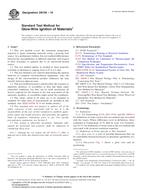Potřebujeme váš souhlas k využití jednotlivých dat, aby se vám mimo jiné mohly ukazovat informace týkající se vašich zájmů. Souhlas udělíte kliknutím na tlačítko „OK“.
ASTM D6194-10
Standard Test Method for Glow-Wire Ignition of Materials
Automaticky přeložený název:
Standardní zkušební metoda pro Glow -Wire zapalování materiálů
NORMA vydána dne 1.3.2010
Informace o normě:
Označení normy: ASTM D6194-10
Poznámka: NEPLATNÁ
Datum vydání normy: 1.3.2010
Kód zboží: NS-34173
Počet stran: 5
Přibližná hmotnost: 15 g (0.03 liber)
Země: Americká technická norma
Kategorie: Technické normy ASTM
Anotace textu normy ASTM D6194-10 :
Keywords:
ISO 13943 Fire Safety´Vocabulary , Electrical insulating plastics, Electrically heated sources, Glow-wire ignition, Ignition--electrical insulating materials, ICS Number Code 13.220.40 (Ignitability and burning behaviour of materials and products), 29.035.01 (Insulating materials in general)
Doplňující informace
| Significance and Use | ||||||||||||||||
|
During operation of electrical equipment, including wires, resistors, and other conductors, it is possible for overheating to occur under certain conditions of operation, or when malfunctions occur. When this happens, a possible result is ignition of the adjacent insulation material. This test method assesses the susceptibility of electrical insulating materials to ignition as a result of exposure to a glowing wire. This test method determines the minimum temperature required to ignite a material by the effect of a glowing heat source, under the specified conditions of test. This method is suitable, subject to the appropriate limitations of an expected precision of ±15 %, to categorize materials. 5.5 In this procedure, the specimens are subjected to one or more specific sets of laboratory conditions. If different test conditions are substituted or the end-use conditions are changed, it is not always possible by or from this test to predict changes in the fire-test-response characteristics measured. Therefore, the results are valid only for the fire test exposure conditions described in this procedure. |
||||||||||||||||
| 1. Scope | ||||||||||||||||
|
1.1 This test method covers the minimum temperature required to ignite insulating materials using a glowing heat source. In a preliminary fashion, this test method differentiates between the susceptibilities of different materials with respect to their resistance to ignition due to an electrically-heated source. 1.2 This test method applies to molded or sheet materials available in thicknesses ranging from 0.25 to 6.4 mm. 1.3 This test method is not valid for determining the ignition behavior of complete electrotechnical equipment, since the design of the electrotechnical product influences the heat transfer between adjacent parts. 1.4 This test method measures and describes the response or materials, products, or assemblies to heat and flame under controlled conditions, but does not by itself incorporate all factors required for fire hazard or fire risk assessment of the materials, products, or assemblies under actual fire conditions. 1.5 The values stated in SI units are to be regarded as standard. No other units of measurement are included in this standard. (See for further details.) 1.6 This standard does not purport to address all of the safety concerns, if any, associated with its use. It is the responsibility of the user of this standard to establish appropriate safety and health practices and determine the applicability of regulatory limitations prior to use. For specific precautionary statements, see Section 9. 1.7 Fire testing is inherently hazardous. Adequate safeguards for personnel and property shall be employed in conducting these tests. Note 1—Although this test method and IEC 60695-2-13 differ in approach and in detail, data obtained using either are technically equivalent. |
||||||||||||||||
| 2. Referenced Documents | ||||||||||||||||
|
Doporučujeme:
Aktualizace technických norem
Chcete mít jistotu, že používáte pouze platné technické normy?
Nabízíme Vám řešení, které Vám zajistí měsíční přehled o aktuálnosti norem, které používáte.
Chcete vědět více informací? Podívejte se na tuto stránku.




 Cookies
Cookies
